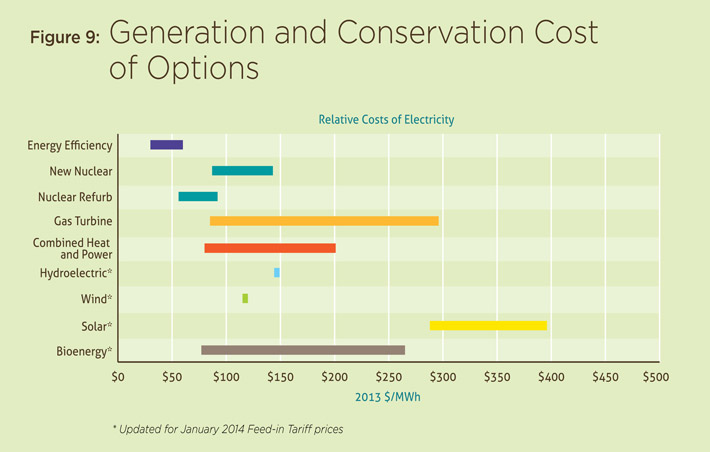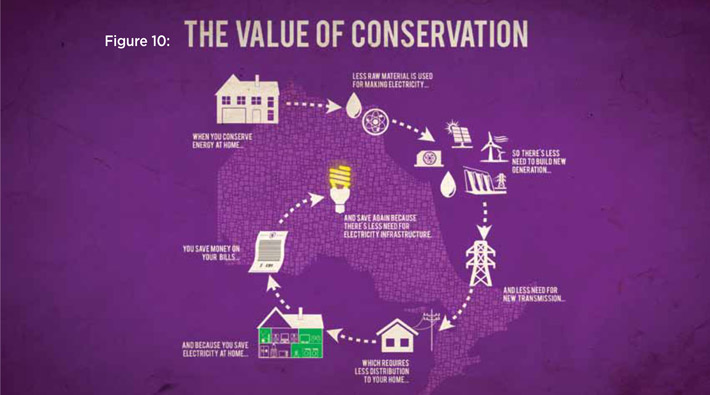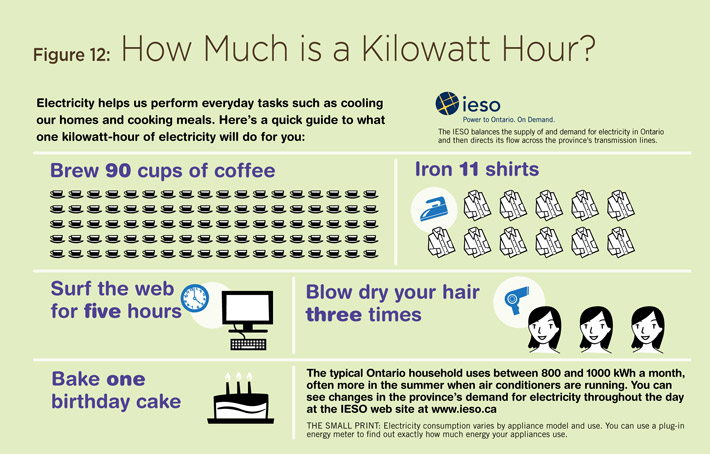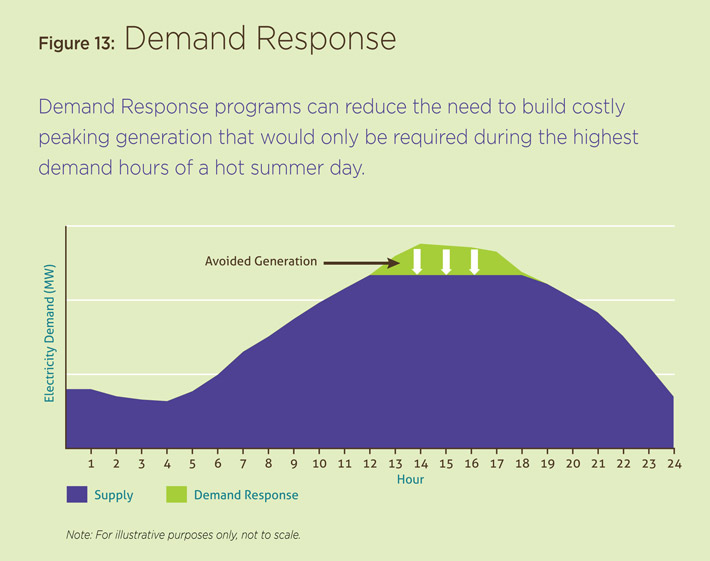The content on this page is no longer up to date. It will remain on ontario.ca for a limited time before it moves to the Archives of Ontario.
Putting Conservation First
As we plan for Ontario’s electricity needs for the next 20 years, conservation will be the first resource to be considered. It is the cleanest and most cost-effective energy resource, and it offers consumers a way to reduce their electricity bills. The government intends to ensure that conservation will be considered before building new generation and transmission facilities, and will be the preferred choice wherever cost-effective.
The ministry will work with its agencies to ensure that they put conservation first in their planning, approval and procurement processes. The ministry will also work with the OEB to incorporate the policy of Conservation First into distributor planning processes for both electricity and natural gas utilities.
Our agencies and partners will achieve this goal with a combination of tools, including the Total Resource Cost Test, the Program Administrator Cost Test and a hurdle rate, to screen program proposals. A hurdle rate would consider the cost of delivering a conservation program against the avoided cost of procuring supply.
Ontarians are making considerable progress in embracing a culture of conservation. Since 2005, conservation efforts have increased significantly, and it is projected that by the end of 2013, Ontarians will have conserved 8.6 TWh of electricity - enough to power a city about the size of Mississauga.
The province expects to offset most of the growth in electricity demand to 2032 using programs and improved codes and standards. This will lessen the need for new supply. Our long-term conservation target of 30 TWh in 2032 represents a 16% reduction in forecast gross demand for electricity - the equivalent to more than all the power used by the City of Toronto in 2012 - an improvement over the 2010 LTEP.
Putting conservation first will require a number of changes to our approach. In collaboration with its agencies and partners, the ministry will work on new conservation initiatives, significantly increase Demand Response capability, and give LDCs a greater role and more flexibility to address local conditions.
The government is committed to promoting a co-ordinated approach for all customers, including both electricity and natural gas utilities.
The government will work to make new financing tools available to consumers starting in 2015. These tools will include on-bill financing to help them with the upfront cost of making energy efficiency retrofits to conserve electricity and natural gas. The government has already enabled municipal governments to offer Local Improvement Charges to recover energy efficiency and renewable energy investments with repayment through property taxes. This allows consumers to save money on their energy bill and pay off conservation investments over time as they receive the benefits of conservation.
To help consumers choose the most efficient products for their homes and businesses, Ontario will provide information and incentives and continue to show leadership in establishing minimum efficiency requirements for products such as water heaters, clothes dryers, televisions, fluorescent lamps, motors and boilers.
The government, its energy agencies and its partners are also developing new ways to get consumers the information they need to make more informed decisions about their energy consumption.
On-Bill Financing
Manitoba Hydro offers a financing program that makes energy efficiency accessible to homeowners. Using on-bill financing, the Power Smart PAYS Financing Program provides Manitoba residential customers with a convenient option for completing energy-efficient upgrades to their homes while keeping the upfront costs and future monthly finance payments as small as possible.
Source: Manitoba Hydro

The Green Button Initiative gives consumers access to their energy data and the ability to connect to mobile and web-based applications so they can analyze and manage their energy use. The combination of data and the innovative applications could also guide them in making the investment decisions necessary to improve their energy efficiency.
The government looks forward to releasing the results of the innovative, forward-looking Energy Apps for Ontario Challenge in early 2014. This consumer-friendly initiative will enable Ontarians to better manage and track their electricity use and encourage conservation.
Social benchmarking can increase awareness of energy use and promote conservation. A social benchmarking pilot program is under way, led by the OPA, to test different approaches that enable consumers to compare their energy consumption with other similar consumers. Pending the success of the pilot program, the government will explore expanding social benchmarking.
From the outset, Green Button was designed with privacy and security principles embedded into the standard. Social benchmarking initiatives will also take proactive steps to ensure consumer privacy is protected by embedding privacy directly into the design of technologies, business practices and networked infrastructures.
The government is also working with Ontario EcoSchools to bring more information about energy conservation into classrooms. Ontario EcoSchools uses the local school as an energy education resource, encouraging students to reduce energy use in the classroom and providing them with skills they can take back home.
Demand Response
Ontarians may not be familiar with the concept of Demand Response (DR), but many practice it every day with their smart meters and time-of-use (TOU) pricing. DR occurs when people and businesses shift electricity use from periods of peak demand to periods of lower demand, or reduce use during peak periods. This helps avoid the cost of building costly generation and transmission to meet a few short periods of peak demand a year.
Ontario consumers can participate in DR programs in several different ways. One program is peaksaver PLUS, where homeowners agree to reduce their electricity consumption during critical periods of peak demand. Another program encourages large commercial and industrial facilities to make firm commitments to reduce energy use during high demand periods. This can mean turning off lights or motors or shifting production to other times of the day.
Ontario is aiming to use DR to meet 10% of peak demand by 2025, equivalent to approximately 2,400 MW under forecast conditions. To encourage further development of DR in Ontario, the IESO will evolve existing programs and introduce new initiatives. This will allow the IESO to work directly with large electricity consumers such as commercial and industrial facilities, and other large facilities that can reduce their electrical consumption on demand in response to system need. The IESO, as the system operator, is in the best position to enable these large consumers to provide DR to the grid in a manner that puts DR on par with comparable generation options.
Additionally, the IESO will continue to examine and consult on the potential benefits and development of a capacity market, where different generation and demand resources, including electricity storage technologies, conservation initiatives and clean imports compete to address capacity needs.
Conservation and Demand Management Framework
Ontario has achieved a great deal through conservation, but we did not accomplish this alone. LDCs are the face of electricity conservation for most Ontarians, delivering programs to their local communities.
In 2010, the government established a Conservation and Demand Management Framework that included mandatory conservation targets for LDCs. While we’ve made real progress, full achievement of our goals has been difficult because of reduced opportunities for conservation. This came about because of the decreased demand for electricity and the constrained financial circumstances that made many businesses reluctant to invest in conservation. Challenges associated with the Framework itself, such as a lack of flexibility and slower than expected roll-out of programs, also made it difficult to achieve the conservation targets.


| Source | % |
|---|---|
| Bioenergy | 1% |
| Wind | 3% |
| Hydro | 22% |
| Gas |
10% |
| Coal | 2% |
| Solar PV | 1% |
| Conservation |
1% |
| Nuclear | 56% |
| Source | % |
|---|---|
| Conservation |
16% |
| Solar PV | 2% |
| Bioenergy | 2% |
| Wind | 9% |
| Hydro | 22% |
| Planned Flexibility | <1% |
| Nuclear | 39% |
| Gas |
10% |
Note: Charts represent total forecast energy production. For comparative purposes, total production has been increased by the amount of energy conserved to demonstrate the role of conservation.

Electricity helps us perform everyday tasks such as cooling our homes and cooking meals. Here’s a quick guide to what one kilowatt-hour of electricity will do for you: Brew 90 cups of coffee. Iron 11 shirts. Surf the web for five hours. Blow dry your hair three times. Bake one birthday cake. The typical Ontario household uses between 800 and 1000 kWh a month, often more in the summer when air conditioners are running. You can see changes in the province’s demand for electricity throughout the day at the IESO web site at www.ieso.ca THE SMALL PRINT: Electricity consumption varies by appliance model and use. You can use a plug-in energy meter to find out exactly how much energy your appliances use.
Ontario EcoSchools
Ontario EcoSchools is an environmental education and certification program for grades K-12 that helps school communities develop both ecological literacy and environmental practices to become environmentally responsible citizens and reduce the environmental footprint of schools.The key areas of focus and achievement are:Teamwork and Leadership, Energy Conservation, Waste Minimization, School Ground Greening, Curriculum, and Environmental Stewardship.Schools may use the program free of charge.
Source: http://ontarioecoschools.org/

The government, in co-operation with LDCs and energy agencies, is developing a new Conservation and Demand Management Framework to begin in January 2015, lasting for six years and replacing the one that is currently winding down. Subject to further discussion with our partners, the government intends to build the new Framework on the following principles:
- There will be long-term, stable funding for conservation so that customers and LDCs have the certainty they need to implement and deliver programs.
- Customers will be given more program choice along with streamlined oversight and administration.
- LDCs will have accountability for meeting their assigned conservation goals, and will be provided the authority and means for meeting them cost-effectively.
- The new Framework will encourage innovation and the adoption of new technologies.
- While there will be conservation programs available for all residential, commercial and industrial sectors, the value of conservation investments may be higher in some sectors than others.
- There will be renewed efforts to deepen consumer awareness of conservation, and more broadly, of the electricity system.
- Conservation programs for low-income residential customers will be improved.
- For Aboriginal communities, the role of LDCs in the delivery of conservation programs will be enhanced, particularly for on-reserve First Nation customers.
- Industrial and transmission-connected customers will continue to have access to the OPA’s conservation programs, which will be expanded to facilitate broader program choice and financing flexibility.
To ensure value for ratepayers, the new Framework will continue to provide cost-effective conservation programs at less than the cost of new supply.
In Summary
- The Ministry of Energy will work with its agencies to ensure they put conservation first in their planning, approval and procurement processes. The ministry will also work with the Ontario Energy Board (OEB) to incorporate the policy of conservation first into distributor planning processes for both electricity and natural gas utilities.
- The province expects to offset almost all of the growth in electricity demand to 2032 by using programs and improved codes and standards. This will lessen the need for new supply. Our long-term conservation target of 30 terawatt-hours (TWh) in 2032 represents a 16% reduction in the gross demand for electricity, an improvement over the 2010 LTEP.
- Ontario is aiming to use Demand Response (DR) to meet 10% of peak demand by 2025, equivalent to approximately 2,400 megawatts (MW) under forecast conditions. To encourage further development of DR in Ontario, the Independent Electricity System Operator (IESO) will evolve existing DR programs and introduce new DR initiatives.
- The IESO will continue to examine and consult on the potential benefits and development of a capacity market, where different generation and demand resources compete to address capacity needs.
- The government is committed to promoting a co-ordinated approach to conservation and will encourage collaboration of conservation efforts among electricity and natural gas utilities.
- The government will work to make new financing tools available to consumers starting in 2015, including on-bill financing for energy efficiency retrofits.
- To help consumers choose the most efficient products for their homes and businesses, Ontario will provide information and incentives; it will also continue to show leadership in establishing minimum efficiency requirements for products such as water heaters, clothes dryers, televisions, fluorescent lamps, motors and boilers.
- The Green Button Initiative will give consumers access to their energy data and the ability to connect to mobile and web-based applications so they can analyze and manage their energy use.
- Social benchmarking can increase awareness of energy use and promote conservation. A social benchmarking pilot program is under way, led by the Ontario Power Authority (OPA) to test different approaches that enable consumers to compare their energy consumption with other similar consumers. Pending the success of the pilot program, the government will explore expanding social benchmarking and including other sectors.
- The government is also working with Ontario EcoSchools to bring more resources about energy conservation to the curriculum for students and teachers.
Footnotes
- footnote[2] Back to paragraph Includes Lennox Generating Station – dual fueled with natural gas and oil.
- footnote[1] Back to paragraph Conservation is forecast to contribute 30 TWh of energy efficiency in 2032, which is equal to 16% of the forecast gross demand.